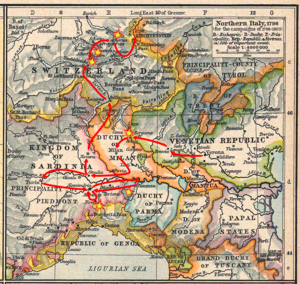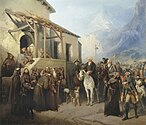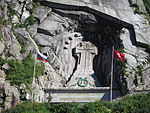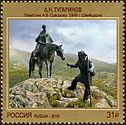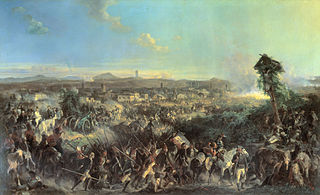
The Battle of Novi saw a combined army of the Habsburg monarchy and Imperial Russians under Field Marshal Alexander Suvorov attack a Republican French army under General Barthélemy Catherine Joubert. As soon as Joubert fell during the battle, Jean Victor Marie Moreau immediately took overall command of the French forces. After a prolonged and bloody struggle, the Austro-Russians broke through the French defenses and drove their enemies into a disorderly retreat, while French division commanders Catherine-Dominique de Pérignon and Emmanuel Grouchy were captured. Novi Ligure is in the province of Piedmont in Northern Italy a distance of 58 kilometres (36 mi) north of Genoa. The battle occurred during the War of the Second Coalition which was part of the French Revolutionary Wars.

André Masséna, Prince of Essling, Duke of Rivoli, was a French military commander during the French Revolutionary Wars and the Napoleonic Wars. He was one of the original 18 Marshals of the Empire created by Napoleon I. He was nicknamed l'Enfant chéri de la Victoire. He is considered to be one of the greatest generals of the Revolutionary and Napoleonic Wars.

The French Revolutionary Wars were a series of sweeping military conflicts resulting from the French Revolution that lasted from 1792 until 1802. They pitted France against Great Britain, Austria, Prussia, Russia, and several other countries. The wars are divided into two periods: the War of the First Coalition (1792–1797) and the War of the Second Coalition (1798–1802). Initially confined to Europe, the fighting gradually assumed a global dimension. After a decade of constant warfare and aggressive diplomacy, France had conquered territories in the Italian Peninsula, the Low Countries and the Rhineland. French success in these conflicts ensured the spread of revolutionary principles over much of Europe.
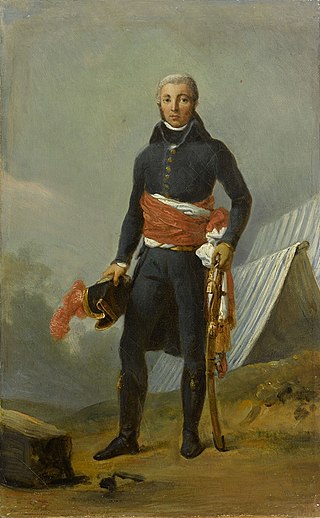
Jean Victor Marie Moreau was a French general who helped Napoleon Bonaparte rise to power, but later became his chief military and political rival and was banished to the United States. He is among the foremost French generals in military history.

The War of the Second Coalition was the second war targeting revolutionary France by many European monarchies, led by Britain, Austria, and Russia and including the Ottoman Empire, Portugal, Naples and various German monarchies. Prussia did not join the coalition, while Spain supported France.
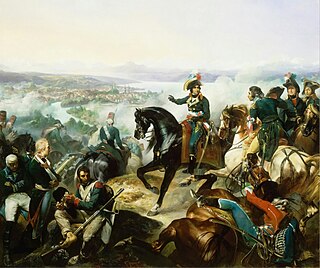
The Second Battle of Zurich was a key victory by the Republican French army in Switzerland led by André Masséna over a Russian force commanded by Alexander Korsakov near Zürich. It broke the stalemate that had resulted from the First Battle of Zurich three months earlier and led to the withdrawal of Russia from the Second Coalition. Most of the fighting took place on both banks of the river Limmat up to the gates of Zürich, and within the city itself. The same days saw a battle between Hotze's Austrians and Soult's French at the River Linth. It was arguably the most significant French victory of 1799–1800.
By 1799, the French Revolutionary Wars had resumed after a period of relative peace in 1798. The Second Coalition had organized against France, with Great Britain allying with Russia, Austria, the Ottoman Empire, and several of the German and Italian states. While Napoleon's army was still embroiled in Egypt, the allies prepared campaigns in Italy, Switzerland, and the Netherlands.
The Napoleonic Wars continued from 1799 with the French fighting the forces of the Second Coalition. Napoleon Bonaparte had returned from Egypt and taken control of the French government, marking the end of the French Revolution. He prepared a new campaign, sending Moreau to the Rhine frontier and personally going to take command in the Alps, where French forces had been driven almost out of Italy in 1799.

The Italian campaigns of the French Revolutionary Wars (1792–1801) were a series of conflicts fought principally in Northern Italy between the French Revolutionary Army and a Coalition of Austria, Russia, Piedmont-Sardinia, and a number of other Italian states.

The Battle of Cassano was fought in 1799 from 27 to 28 April near Cassano d'Adda, which about 28 km (17 mi) ENE of Milan. The clash is part of the battle of the Adda River or the so-called forcing of the Adda, which on the first day of 26 April resulted in a minor victory for the Russians under the Count Suvorov over Barthélemy Schérer's French forces at Lecco. Then, on the second day, Suvorov's Austrians and Cossacks prevailed over Jean Moreau's army, who replaced Schérer as supreme commander, and trapped his isolated division on the third. The action took place during the War of the Second Coalition, as part of the larger conflict known as the French Revolutionary Wars.

Alexander Mikhailovich Rimsky-Korsakov was a Russian general remembered as an unlucky assistant to Alexander Suvorov during his Swiss expedition of 1799–1800.

Michael Friedrich Benedikt Baron von Melas was a Transylvanian-born field marshal of Greek descent for the Austrian Empire during the Napoleonic Wars.
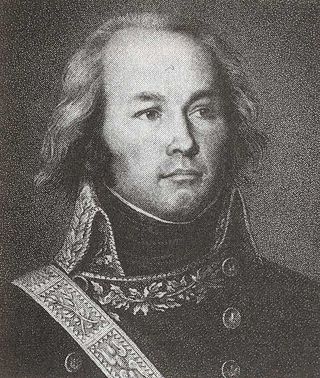
Claude Jacques Lecourbe was a French general during the French Revolutionary and Napoleonic wars.
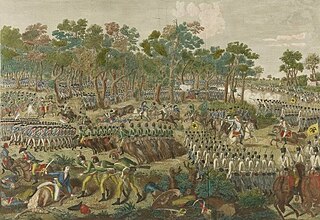
In the Battle of Magnano on 5 April 1799, an Austrian army commanded by Pál Kray defeated a French army led by Barthélemy Schérer. In subsequent battles, the Austrians and their Russian allies drove the French out of nearly all of Italy. This action was fought during the War of the Second Coalition, part of the French Revolutionary Wars.

Friedrich Freiherr (Baron) von Hotze, was a Swiss-born general in the Austrian army during the French Revolutionary Wars. He campaigned in the Rhineland during the War of the First Coalition and in Switzerland in the War of the Second Coalition, notably at Battle of Winterthur in late May 1799, and the First Battle of Zurich in early June 1799. He was killed at the Battle of Linth River.
The Battle of Bassignana saw a Russian corps led by Andrei Grigorevich Rosenberg, who was under the influence of Grand Duke Constantine, attempt to establish a bridgehead on the south bank of the Po River in the presence of a French army under Jean Victor Marie Moreau. The French rapidly massed superior strength and attacked. After several hours of hard fighting, the Russians abandoned their foothold with serious losses. This War of the Second Coalition action occurred near the town of Bassignana, located in the angle between the Po and Tanaro Rivers, about 19 kilometres (12 mi) northeast of Alessandria, Italy.

The Battle of Mannheim was fought between an Austrian army commanded by Archduke Charles, Duke of Teschen and a French army under Jacques Léonard Muller. Most of the French Army of the Rhine had retreated to the west bank of the Rhine River, leaving the division of Antoine Laroche Dubouscat to hold Mannheim on the east bank. Despite assistance by Michel Ney, Laroche's division was beaten and driven out of the city when attacked by Charles and a much superior force. The War of the Second Coalition action occurred in the city of Mannheim, today located in the state of Baden-Württemberg in southwest Germany about 80 kilometres (50 mi) south of Frankfurt.

The Piedmontese Republic was a revolutionary, provisional and internationally unrecognized government established in Turin between 1798 and 1799 on the territory of Piedmont during its military rule by the French First Republic.
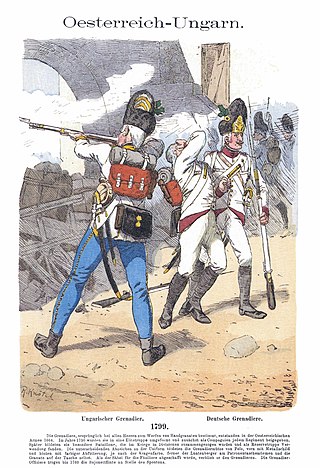
The First Battle of Marengo or Battle of San Giuliano saw Republican French soldiers under General of Division Jean Victor Marie Moreau launch a reconnaissance in force against a larger force of Habsburg Austrian and Imperial Russian troops led by Field Marshal Alexander Suvorov. The French enjoyed initial success, pressing back their opponents. However, large Austrian and Russian reinforcements soon arrived, causing the French to withdraw into Alessandria. This War of the Second Coalition meeting engagement occurred near the town of Spinetta Marengo, located just east of Alessandria in northwest Italy.
The Second Battle of Marengo or Battle of Cascina Grossa saw French troops under General of Division Jean Victor Marie Moreau clash with a force of Austrian soldiers led by Feldmarschall-Leutnant Heinrich von Bellegarde. The early fighting between Emmanuel Grouchy's division and Bellegarde was inconclusive. However, late in the day Moreau committed Paul Grenier's French division to the struggle and the Austrians were driven from the field. This War of the Second Coalition battle occurred near Spinetta Marengo which is just east of Alessandria, Italy.
